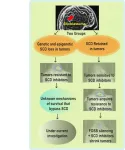(Press-News.org) Individual choices in medicine carry a certain amount of uncertainty.
An innovative partnership at The University of Texas at Austin takes aim at medicine down to the individual level by applying state-of-the-art computation to medical care.
"Medicine in its essence is decision-making under uncertainty, decisions about tests and treatments," said Radek Bukowski, MD, PhD, professor and associate chair of Investigation and Discovery in the Department of Women's Health at Dell Medical School at UT Austin.
"The human body and the healthcare system are complex systems made of a vast number of intensely interacting elements," he said. "In such complex systems, there are many different pathways along which an outcome can occur. Our bodies are robust, but this also makes us very individualized, and the practice of medicine challenging. Everyone is made of different combinations of risk factors and protective characteristics. This is why precision medicine is paramount going forward."
To that effect, in the January 2021 edition of the American Journal of Obstetrics Gynecology, experts at Dell Med, Oden Institute for Computational and Engineering Sciences (Oden Institute), and Texas Advanced Computing Center (TACC), along with stakeholders across healthcare, industry, and government, stated that the emergence of computational medicine will revolutionize the future of medicine and health care. Craig Cordola of Ascension and Christopher Zarins of HeartFlow co-authored this editorial review with Bukowski and others.
According to Bukowski, this interdisciplinary group provides a unique combination of resources that are poised to make Texas a leader in providing computational solutions to today's and tomorrow's health care issues.
"At UT Austin we're fortunate to have found ourselves at a very opportune point in time for computational medical research," Bukowski said. "The Oden Institute has world-class expertise in mathematical modeling, applied math, and computational medicine; TACC is home to the world's largest supercomputer for open science, and also committed to improving medical care, including outcomes for women and babies."
Powered by such collaborations, the emerging discipline of computational medicine focuses on developing quantitative approaches to understanding the mechanisms, diagnosis, and treatment of human disease through applications, more commonly found in mathematics, engineering, and computational science. These computational approaches are well-suited to modeling complex systems such as the human body.
An On-Point area of Study for Obstetrics
While computation is pivotal to all domains in medicine, it is especially promising in obstetrics because it concerns at least two patients -- mother and baby, who frequently have conflicting interests, making medical decision-making particularly difficult and the stakes exceptionally high.
According to state Rep. Donna Howard, D-Austin, a co-author of the editorial review, Texas legislators should be concerned about the unacceptably high rate of maternal morbidity and mortality in the state.
"When I became aware of the efforts to bring computational medical approaches to addressing maternal morbidity and mortality, I was immediately intrigued," Howard said. "And when I learned of the interdisciplinary expertise that has found itself conveniently positioned to create this new frontier of medicine, I was sold."
Individualized medicine is happening now because of advancements in computing power and mathematical modeling that can solve the problems which were unsolvable until now.
Case in point: in 2018 the National Science Foundation awarded UT Austin a $1.2 million grant to support research using computational medicine and smartphones to monitor the activity and behavior of 1,000 pregnant women in the Austin area.
In particular, the growing array of data sources including health records, administrative databases, randomized controlled trials, and internet-connected sensors provides a wealth of information at multiple timescales for which to develop sophisticated data-driven models and inform theoretical formulations.
"When combined with analysis platforms via high performance computing, we now have the capability to provide patients and medical providers analysis of outcomes and risk assessment on a per-individual basis to improve the shared decision making process," Bukowski concluded.
INFORMATION:
The study, "Computational medicine, present and the future: obstetrics and gynecology perspective," was published in the American Journal of Obstetrics and Gynecology, January 2021. The editorial review authors are Radek Bukowski MD, PhD; Karl Schulz PhD; Kelly Gaither PhD; Keri K. Stephens PhD; Dave Semeraro PhD; Justin Drake PhD; Gordon Smith MD, PhD; Craig Cordola FACHE; Thaleia Zariphopoulou PhD; Thomas J.R. Hughes PhD; Christopher Zarins MD; Dimitri Kusnezov PhD; Rep. Donna Howard MA; and Tinsley Oden PhD.
Firefighters and emergency medical services workers are at high risk of exposure to COVID-19 while on the job and pose an additional risk of transmitting the virus to others. Although vaccines are a promising public health tool for reducing COVID-19 transmission, little has been known about the perceptions of the COVID-19 vaccine among first responders.
To provide insight, a University of Miami Miller School of Medicine-led study queried a national sample of U.S. firefighters and emergency medical services workers through an anonymous online survey. The study results, published online Feb. 1 in the Journal of Occupational ...
Ten years ago, researchers at Aarhus University, Denmark, reported the discovery of centimeter-long cable bacteria, that live by conducting an electric current from one end to the other. Now the researchers document that a few cells operate with extremely high oxygen consumption while the rest of the cells process food and grow without oxygen. An outstanding way of life.
We humans need food and oxygen to live.
Now, imagine if oxygen was to be found only at the mountain top and food only in the valley. That's how the world looks like for cable bacteria, which live in the bottom of seas and lakes. For them, ...
In far too many cases over the years, scientists have discovered promising new cancer treatments, only to report later that the tumor cells found ways to become resistant. These disappointing results have made overcoming drug resistance a major goal in cancer research.
Now, experts at Cincinnati Children's report success at averting drug resistance in a subtype of brain tumors called glioblastomas. Importantly, the research indicates that the approach may also work in other cancers, such as melanoma, that exhibit a similar pathway of drug resistance.
The method involves inhibiting a protein called SCD and reducing the ...
A potent ozone-depleting chemical whose emissions unexpectedly spiked in recent years has quickly dropped back to much lower levels, putting the recovery of the stratospheric ozone layer back on track, according to a new study by scientists at MIT, the University of Bristol, and other institutions in South Korea, the U.S., Japan, Australia, and Switzerland.
The chemical in question is CFC-11, a chlorofluorocarbon that was once commonly used for refrigeration, insulation, and other purposes. When emitted to the atmosphere, CFC-11 can loft into the stratosphere, where the sun's ultraviolet radiation breaks the chemical down to release chlorine -- a noxious chemical that then eats ...
In the face of a changing climate and crop diseases, manufacturers of products containing natural flavors and fragrances are pivoting to a new way to source ingredients. Companies have been partnering with biotechnology firms to manufacture scents and flavors using fermented microbes, which experts say are more sustainable. A new story in Chemical & Engineering News (C&EN), the weekly newsmagazine of the American Chemical Society, details how the industry is brewing up new fragrances.
Although the availability of natural fragrances and flavors like citrus and vanilla is dwindling, the demand for them has increased, writes Senior Business Editor Melody Bomgardner. In recent years, flavor and fragrance companies have been working with the biotech industry to shore ...
Rates of overweight and obesity in children are rising around the world, with serious long-term consequences for health and health care costs. In prior research, video and mobile games have helped children eat healthier and exercise more. A new study examined how Indian 10- and 11-year-olds' food choices were affected by playing a pediatric dietary mobile game that uses implicit learning--educating players without making them aware of the lessons through innovations in neurocognitive training and immersive technology. The study found that the game significantly improved children's food choices immediately after play.
The study was conducted by researchers at Carnegie Mellon University (CMU), Hofstra University, Johns Hopkins University Center for Communication Programs (CCP), ...
The visibility of scientific articles and conference papers is conditional upon being easily found in academic search engines, especially Google Scholar. To enhance this visibility, search engine optimization (SEO) has been applied in recent years to academic search engines in order to optimize documents and, thereby, ensure they are better ranked in search pages (i.e., academic search engine optimization or ASEO).
Recent research, published in Future Internet, has found out whether the language of the document is a factor involved in the sorting algorithm of search results on Google Scholar. The study authors are Cristòfol Rovira, Lluís Codina and ...
Because of their small size, some microorganisms can come through the pores of bacterial filters. Such filtrable microorganisms are difficult to grow in lab conditions and therefore remain understudied. Scientists believe that filtrable microorganisms are widely spread in the biosphere and participate in many biogeochemical processes, such as the restoration of sulfur in deep-see regions. They also play an important role in the production and use of dissolved organic matter. This term refers to a group of compounds (such as amino acids, organic acids and monomeric sugars) that are easily utilizable sources of nutrients in freshwater systems.
These compounds occur in pristine lotic systems at very low concentrations mainly from primary producers ...
FRANKFURT. The lens of the human eye gets its transparency and refractive power from the fact that certain proteins are densely packed in its cells. These are mainly crystallines. If this dense packing cannot be maintained, for example due to hereditary changes in the crystallines, the result is lens opacities, known as cataracts, which are the most common cause of vision loss worldwide.
In order for crystallins to be packed tightly in lens fibre cells, they must be folded stably and correctly. Protein folding already begins during the biosynthesis of proteins in the ribosomes, which are large protein complexes. Ribosomes ...
Seismic monitoring devices linked to the internet are vulnerable to cyberattacks that could disrupt data collection and processing, say researchers who have probed the devices for weak points.
Common security issues such as non-encrypted data, insecure protocols, and poor user authentication mechanisms are among the biggest culprits that leave seismological networks open to security breaches, Michael Samios of the National Observatory of Athens and colleagues write in a new study published in Seismological Research Letters.
Modern seismic stations are now implemented as an Internet-of-Things (IoT) station, with physical devices that connect and exchange data with other devices and systems over the Internet. In their test attacks ...


